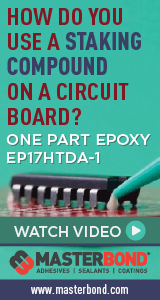|

|
|
Ask the Experts Member |
|||||
|
|||||
Gary FreedmanPresident Colab Engineering |
|||||
|
A thirty year veteran of electronics assembly with major OEMs including Digital Equipment Corp., Compaq and Hewlett-Packard. President of Colab Engineering, LLC; a consulting agency specializing in electronics manufacturing, root-cause analysis and manufacturing improvement. Holder of six U.S. process patents. Authored several sections and chapters on circuit assembly for industry handbooks. Wrote a treatise on laser soldering for Laser Institute of America's LIA Handbook of Laser Materials Processing. Diverse background includes significant stints and contributions in electrochemistry, photovoltaics, silicon crystal growth and laser processing prior to entering the world of PCAs. Member of SMTA. Member of the Technical Journal Committee of the Surface Mount Technology Association.
Gary Freedman has submitted responses to the following questions.
Solder Ball Wrinkles
During the soldering process flux reacts with the solder oxides (oxides of Sn and Pb) and breaks them down to ...
Baking Old PCBs Prior To Reflow
If sealed, desiccated, and monitored with indicator cards, there’s no need for baking older PCBs as mentioned in the question. ...
Flux Residue During Pin-in-Paste
Interesting question and difficult to answer without additional detail, but I will try to answer in a generic manner. The ...
Depaneling circuit board that contain BGA components
Rotary-wheel (pizza-cutter) type depaneling can be effective. If this is used strain-gaging is commonly employed to ensure that any forces ...
Application Using No-Clean and Water Soluble Fluxes
Use of water-clean flux defeats the purpose of no-clean and also jeopardizes reliability. The water-soluble flux has to be cleaned ...
OA Flux Turning Blue
The flux is likely corroding copper or other exposed metal. OA flux is meant to be cleaned shortly after soldering ...
No-Clean Flux Residue After Selective Soldering
If the No-Clean flux has been fully activated (experienced a temperature cycle commensurate with the flux or paste manufacturer's solder ...
Solution for Warped PCBAs
Flattening may jeopardize solder joint integrity inducing cracks immediately or with time. This is always a worry when mounting a ...
Requirement for Toe Fillets
When one talks about toe fillets, one has to discuss solderability. Often in the manufacture of ICs lead-frames are separated/die-cut ...
Stencil Pattern for Thermal Pads on QFNs
QFNs, like all devices, are designed with electrical, mechanical and thermal requirements in mind. The enlarged "ground" pad on the ...
Mixed Process Solder Joint Appearance, Smooth or Grainy?
In most any soldering application the solder (paste) will dictate the appearance of the joint. The small metallurgical contributions from ...
QFN Test Failures Caused by Flux
Most likely thermal failure is due to excessive voids in the ground pad of the QFN. The voids limit thermal ...
Components Jumping Around During Reflow
It is difficult to know what is causing "components jumping around" without seeing the post-reflow boards. The Pb-free soldering profile ...
Solder Paste Past Shelf Life
Best to follow solder paste manufacturer's recommendations,however, it would be worthwhile to print some and test it before recycling the ...
Production Floor Temperature and Humidity Loggers
The answer is dependent on the uniformity of the temperature and humidity within the room or on the factory floor. ...
ESD Grounding - 1 Meg Ohm Resistor
A high resistance, such as 1 MΩ, is used to discharge static slowly. Discharging static electricity quickly results in a ...
Rechecking Thermal Profiles
Thermal profiles should be checked frequently to avoid costly product mishaps. If the reflow oven isn't working properly and doesn't ...
Lead Emission for Selective Soldering
Thereis no good way to calculate lead (Pb) particulate from your selective solderingprocess as there are far too many variables. ...
Frequency of Checking Solder Paste Viscosity
Frequent checks of solder paste viscosity is not generally useful. Most pastes are thixotropic meaning that they paste shear-thin under ...
Excess Flux Residue After Hand Soldering
First, it is assumed that this is a No-Clean flux-cored solder wire. If not, then the residue would have to ...
Solder Paste Viscosity
Paste viscosity can be dependent on many factors including:Formulated (initial viscosity) plus the metal content, of course. The more powder ...
Double Sided Reflow for Micro BGA Components
Forced convection reflow is by far the most prevalent method for manufacture of printed circuit assemblies whether for cell phones ...
Reliability of Automated Soldering vs. Hand Soldering
A process is only as good as its repeatability. Hand soldering is not a repeatable process. Oxides on the soldering ...
A Generic Reflow Profile
Each and every board should have its own profile. Granted there may be some boards so similar that a new ...
Toe Fillet Requirements on Gull Wing Components
Structurally the most significant elements of a gull-wing solder joint are the solder between the pad and the bottom of ...
Dross Particles Sticking to PCBs
Dross sticking to wave soldered PCB surface may be an indication that the time-temperature profile is at fault or the ...
Un-cleaned PCB Assemblies Potted
Aqueous-clean solder chemistries must be cleaned to avoid corrosion even in the case of potted PCAs. The presence of flux ...
Transfer Efficiency Greater Than 100%
Surface tension effects can cause solder paste to stick to the stencil aperture and/or bottom of the stencil. This can ...
Pin-in-Paste Standards
There is no "standard" per se for pin-in-paste (PiP)soldering. The closest we have is IPC-610 workmanship standard for solderjoint quality. ... |
|
Free Newsletter Subscription
Circuitnet is built for professionals who bear the responsibility of looking ahead, imagining the future, and preparing for it. Insert Your Email Address |
|

|



